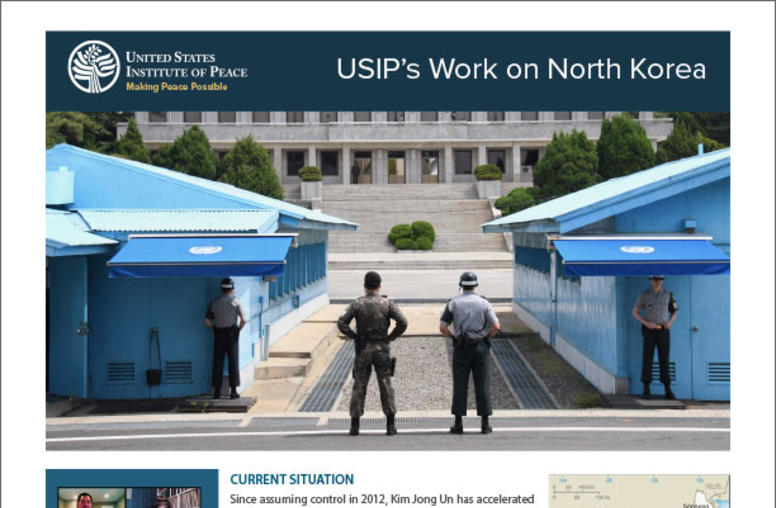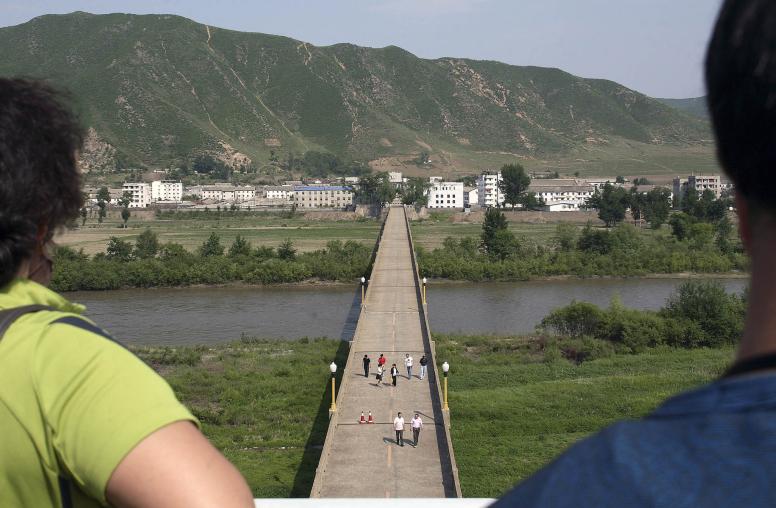Public Health and Conflict in North Korea
During the mid-1990s, North Korea experienced a famine that killed millions of people, mostly in rural areas. Despite the severity of that famine and the ensuing deterioration of public health, the political leadership in North Korea has obstinately blocked the effective delivery of humanitarian aid to its citizens. The USIP/Johns Hopkins School of Public Health Task Force on Public Health and Conflict selected North Korea as a case study for its first symposium.
During the mid-1990s, North Korea experienced a famine that killed millions of people, mostly in rural areas. Despite the severity of that famine and the ensuing deterioration of public health, the political leadership in North Korea has obstinately blocked the effective delivery of humanitarian aid to its citizens.
On November 16, 2006, the United States Institute of Peace (USIP) and Johns Hopkins Bloomberg School of Public Health (JHSPH) Task Force on Public Health and Conflict held its first symposium, which selected North Korea as a case study. The Task Force is committed to raising the profile of conflict analysis and resolution in the field of public health education through a year-long series of events. The speakers at this first symposium included Scott Snyder of the Asia Foundation; Sophie Richardson of Human Rights Watch; two South Korean physicians, Kim Jin-Yong and Lee Yun-Hwan; Courtland Robinson, a Johns Hopkins faculty member and researcher; and one North Korean refugee who addressed the symposium under a pseudonym. This USIPeace Briefing summarizes the symposium's discussion on public health and conflict in North Korea.
Continuing Conflict in North Korea
While North Korea is not currently engaged in a "hot conflict," Linda Bishai of USIP's Education program explained that the country remains within USIP's mandate because of the continuing difficulty in fully resolving the conflict phase and sustaining reconstruction and reconciliation efforts. The political regime of Kim Il-sung and his son Kim Jong-il has been profoundly oppressive. The regime's threats to develop nuclear weaponry and its demonstrated missile tests in 2006 have aggravated North Korea's relationship with the international community.
Despite its official ideology of self-reliance, North Korea relied substantially on support from the Soviet Union and China during the Cold War. After the collapse of the Soviet Union in 1991, North Korea took steps toward to a market economy. Scott Snyder of the Asia Foundation reported that this dramatic change in the economy laid the foundation for the food crises of the mid-1990s. As the country shifted away from relying on the government for food, a struggle emerged between the political leadership, which wanted to manage the change to reinforce the leadership's control, and the emerging markets, in which bottom-up changes were occurring naturally.
Floods were the tipping point for the famines of the mid-1990s, but food shortages and a collapsing national food distribution system created the pre-conditions for the famine's reach and devastation. Sophie Richardson of Human Rights Watch discussed how food was used as a reward for political loyalty during the 1980s and 1990s through the corrupt public distribution system. Between 1990 and 1995, North Korean GDP dropped by fifty percent. The floods, famine, and general public health crises of the 1990s eventually led the North Korean leadership to appeal to the international community for humanitarian assistance.
Declining Health Care
North Korea's socialist health care system promises free and universal access with no out-of-pocket expenses imposed on patients, but this has not been the reality since the collapse of the Soviet Union, which had been North Korea's main trade partner and benefactor. Lee Yun-hwan, a South Korean physician and visiting scholar at JHSPH, presented an overview of North Korea's health care system and the current breakdown in health care provision.
There are, in theory, three tiers to North Korea's health care delivery system. At the first sign of illness patients see their local physician assistant (PA), whose qualifications fall somewhere between a nurse and MD. If necessary, the PA will refer the patient to the secondary level of health care, which is a network of city and county hospitals. Beyond that, the third tier of care consists of hospitals associated with medical schools in each of the nine provinces. If the situation is exceedingly grave, a group of central hospitals in Pyongyang provide the ultimate level of care. Yun-hwan noted that North Korea boasts 300,000 health care personnel trained in both Western and Korean medicine, a total of 800 hospitals with 1383 beds per 100,000 people (compared to 400 beds per 100,000 people in the United States), an almost 1:1 ratio of nurses to physicians, and 297 physicians per 100,000 people. So why, he asked, is the system failing?
Practitioners and hospitals are plentiful, but a lack of medicine and equipment, poor sanitation, and limited energy supply have combined to create a situation in which North Koreans living outside of Pyongyang find it nearly impossible to receive quality treatment. Lack of basic medicinal supplies like nutritional supplements and sterilization kits is only part of the problem. One hospital facility has reported having running water for only one hour a day and no heating, even in the middle of winter.1 Doctors have been forced to hammer out their own operating tools in a makeshift backyard metal shop, and some have little if any anesthetic to use in surgeries. 2
The economic crisis and famine of the 1990s and the subsequent deterioration of the country's sanitation and energy infrastructures have devastated North Korea's once efficient socialist health care system. Doctor Lee reported that 85 percent of people now receiving medical care pay out of pocket with funds that they receive by selling personal items, and that families often must pay 100-140 percent of annual income for each hospital visit.
International Humanitarian Assistance
During the 1990s, the United Nations World Food Program (WFP) and Medecins Sans Frontieres (MSF) were obliged to work under the auspices of the North Korean leadership, and the aid workers had difficulty doing their jobs. These organizations faced limitations on the amount of monitoring and oversight they were allowed to engage in, and aid workers often did not know if the food and medicine were reaching the people who required it. MSF left the country when the North Korean government made it clear that it wanted the tangible benefits of humanitarian aid, but would not allow any person-to-person contact between North Koreans and the aid workers. The government's position is that humanitarian aid is a gift to the state, which has the right to tax, sell, and distribute the aid as it pleases.
Since 1998, international agencies have participated with government counterparts to conduct nutritional surveys to demonstrate the severity of the health problems facing North Korea. The latest WFP survey, carried out in 2004, reported that 37 percent of children were stunted, having a height-for-age ratio significantly below the healthy median. This stunting rate is regarded as a severe public health problem by World Health Organization standards. The survey also reported that 23 percent of children were underweight, having a low weight-for-age ratio; and 7 percent were wasted, having a low weight-for-height ratio.3
Others have conducted studies to garner a more complete picture of the population's health in North Korea. Dr. Courtland Robinson reported to the symposium on recent studies undertaken at the China-North Korea border. Since the 1990s, many tens of thousands of North Koreans have crossed the border into China, seeking shelter, relief, and employment. Surveys conducted with these refugees reveal their impressions of the failing public food distribution system, continued food insecurity, and ongoing problems with international food aid monitoring. In one study, 70 percent of those surveyed had not received any food from state distribution sources.
Life in North Korea
A North Korean refugee, "John" Shin, described his life as a son of a simple laborer. When Shin entered junior high school in the mid-1990s, many people were dying of starvation, North Korean factories were closing down, and he was served nothing more than cold soup at school. Shin became a beggar at a young age and fled back and forth across the Chinese border multiple times. Eventually arrested by North Korean officials for border-crossing and his belief in God (he had been taken in by a Chinese missionary), Shin was imprisoned before finally being granted entry to the United States as a refugee. Shin observed that most of the humanitarian aid coming into North Korea was distributed to government officials, who then sell the supplies to merchants, who in turn sell it on the black market. In his experience, most of the aid is never seen by the North Korean people.
A South Korean doctor, Kim Jin-Yong, told the symposium the story of how he helped five young North Korean refugees cross the border into South Korea. The doctor feared for his life if the authorities ever found him out, but the experience has encouraged him to remain hopeful for a unified Korea.
The Way Forward
One of the primary challenges facing international aid organizations in any context is to meet humanitarian needs in a way that results in transformational change to resolve the core problem, rather than providing temporary and symptomatic treatment. In North Korea, this challenge is more acute. The political leadership in North Korea has been obstinate, linking the receipt of foreign aid to other international demands and political goals: Kim Jong-Il will only consider possible changes within North Korea if his country continues to receive humanitarian aid. On the flip side of that arrangement, it is difficult for the United States to reconcile providing humanitarian assistance to North Korea in the context of prolonged strained relations between the two countries and North Korea's stated nuclear ambitions. Scott Snyder of the Asia Foundation emphasized the need for a coordinated regional approach to address these issues.
Sophie Richardson of Human Rights Watch observed that the human rights community tends to devote a disproportionate amount of attention to civil and political liberties when people around the world are dying of starvation. The human rights community needs to articulate that the right to food is itself a human right. One possible international response to the North Korean public health crisis would be to cut off all aid until a proper monitoring system is in place, but that would eliminate the small percentage of aid that does reach vulnerable groups. The policies adopted by aid agencies and donor countries should strive to provide more aid, not less, to the North Koreans, while collaborating to establish some sort of monitoring mechanism. The best option is to acknowledge that the system does not function and to attempt to fix it through engagement and tough negotiations, without directly using food and medical aid as bargaining tools.
Notes
1. Jonathan Watts, "Health-care Divide Widens in North Korea," The Lancet 362 (2003): 2072-73.
2. Elizabeth Rosenthal, "Collapse of Health System Adds to North Korea's Crisis," New York Times, February 20, 2001.
3. United Nations World Food Program online, accessed on February 20, 2007: http://www.wfp.org/country_brief/indexcountry.asp?country=408
This USIPeace Briefing was written by Sarah Dye, program assistant in USIP’s Education program. The views expressed here are not necessarily those of the Institute, which does not advocate specific policies.
The United States Institute of Peace is an independent, nonpartisan institution established and funded by Congress. Its goals are to help prevent and resolve violent international conflicts, promote post-conflict stability and development, and increase conflict management capacity, tools, and intellectual capital worldwide. The Institute does this by empowering others with knowledge, skills, and resources, as well as by directly engaging in peacebuilding efforts around the globe.





